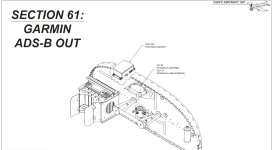2014 RV7a with (2) G3X’s, GTN 650 & GMC 307.
Worked great the last (3) years I’ve owned the plane.
And, now this…
On the GTN 650 I’m getting (all) dropped satellites, which starts at about 10-15 minutes into the flight, or about the time I level off and lean out, which is typically 8K to 14‘K feet. The dropped satellite cycles back on/off for another 5-10 minutes, and then remains in LOI (dropped mode) for awhile. The satellites come all back on when I descend, and all’s back to normal. Important to know that even when all the satellites are dropped, the other NAV and autopilot functions are normal (ie - I can fly it in Heading mode and use the altitude functions). And, comm, lights have no impact.
And, yes, the antenna (I think it’s an GA 35) is installed in the FWF, on a top rack.
The wiring is not loose, nor the the unit in the rack. The coax is tight, but I have not checked the FWF connection yet.
I suspect the antenna is fault, and needs replacement. I think it’s kicking off when it gets hot on the climb and resurrects when things cool on the descent. Wanted to see if other folks have had issues with failed GA 35’s, especially in the FWF area, before I buy a replacement. And, yes, I know the antenna FWF install is not ideal.
Thanks,
Paul
NOTE: See Post #26 if you want the results/solution. If you enjoy the “classic” VAF “never-ending-popcorn-debate,” continue reading.
Worked great the last (3) years I’ve owned the plane.
And, now this…
On the GTN 650 I’m getting (all) dropped satellites, which starts at about 10-15 minutes into the flight, or about the time I level off and lean out, which is typically 8K to 14‘K feet. The dropped satellite cycles back on/off for another 5-10 minutes, and then remains in LOI (dropped mode) for awhile. The satellites come all back on when I descend, and all’s back to normal. Important to know that even when all the satellites are dropped, the other NAV and autopilot functions are normal (ie - I can fly it in Heading mode and use the altitude functions). And, comm, lights have no impact.
And, yes, the antenna (I think it’s an GA 35) is installed in the FWF, on a top rack.
The wiring is not loose, nor the the unit in the rack. The coax is tight, but I have not checked the FWF connection yet.
I suspect the antenna is fault, and needs replacement. I think it’s kicking off when it gets hot on the climb and resurrects when things cool on the descent. Wanted to see if other folks have had issues with failed GA 35’s, especially in the FWF area, before I buy a replacement. And, yes, I know the antenna FWF install is not ideal.
Thanks,
Paul
NOTE: See Post #26 if you want the results/solution. If you enjoy the “classic” VAF “never-ending-popcorn-debate,” continue reading.
Last edited:





